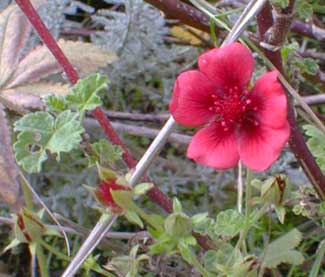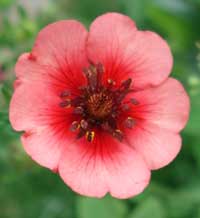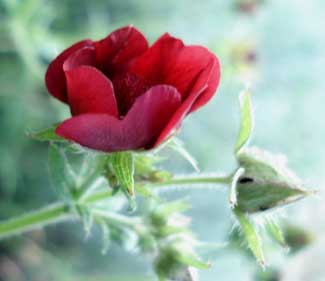
'Monarch's Velvet'
Red, Crimson, or Scarlet Cinquefoil
"Only on some mounded heaps
Cinquefoil creeps,
By whose line you still may pace
Out the place
Where a great house, bravely planned,
Used to stand."
-Cicely Fox Smith
(1882-1954)
(1882-1954)
 Scarlet Cinquefoil has a five-fingered arrangement of leaves, to which the name "cinquefoil" (five-leaf) alludes. The species is native to high elevations in the American Southwest (Arizona & New Mexico).
Scarlet Cinquefoil has a five-fingered arrangement of leaves, to which the name "cinquefoil" (five-leaf) alludes. The species is native to high elevations in the American Southwest (Arizona & New Mexico).The hybrid cultivar Potentilla thurberi maorubens 'Monarch's Velvet' is a softer & much deeper raspberry-red than for the species, with a velvety maroon heart. The bright blooms are less than one-inch round, on long enough stems to be useful for bouquets, though sometimes the flowers close (as in third photo) when brought in the house & don't reopen.
To get the increased color it was apparently pollinated with a hybridized Himalayan P. atrosanguinea x nepalensis. It's a stable cultivar that grows true from seed. If started from seed very early in the year, it is apt to bloom its first year.
 It is extremely cold-hardy (to minus 20 degrees Fahrenheit) & on Puget Sound is evergreen through the winter. Semi-creeping, it spreads rather like its close relative, strawberry vines, into a hardy groundcover; although unlike strawberry vines, its winding branching stems seem not to root themselves at nodes, so the central clump remains singular.
It is extremely cold-hardy (to minus 20 degrees Fahrenheit) & on Puget Sound is evergreen through the winter. Semi-creeping, it spreads rather like its close relative, strawberry vines, into a hardy groundcover; although unlike strawberry vines, its winding branching stems seem not to root themselves at nodes, so the central clump remains singular.It can clump up to a foot or a foot & a half height, looking rather like a hugely oversized strawberry plant but without the berries. The branching stems of blooms reach outward in all directions to a four-foot spread.
These produce flowers from June to first frost or later. If flowering ever seems to have ceased during this period, trim the leafed stems back to the central clump, & it will begin anew.
It requires full sun & very well-draining soil. Although drought-hardy when established, to bloom its best it should have moderate watering during the summer months
In our xeriscape garden where it previoiusly never got sufficient watering, it remained a healthy pleasant enough foliage, but it waited until autumn rains to start blooming. When we changed our watering configuration so that it wouldn't be too droughty in the long summers, it took to blooming the entirety of summer & much of autumn.
An excellent filler-plant that holds its own without displacing surrounding perennials, it is also a fine border plant & useful for containers or hanging baskets. It's a long-lived plant that can be divided every three years or so, in spring, though we can't divide ours because it is growing in the root system of a Chinese mountain ash, the roots of which we would not want to dig into.
See also:
Potentilla nelanesis 'Melton Fire'